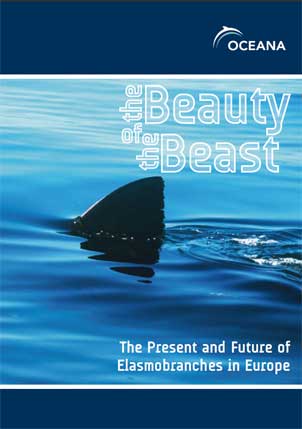Report | April 28, 2010
The beauty of the beast: The present and future of elasmobranches in Europe
Sharks represent one of nature’s most successful creations. They have roamed our oceans for over 400 million years and survived various extinction events to evolve into predators that are perfectly adapted to the marine environment. Early sharks looked very different from today’s modern sharks, but these animals have always had a strategic advantage over their rivals with a hydrodynamic body shape and a flexible skeleton made of cartilage.
The over 1,000 extant species of sharks and related rays, skates, guitarfishes and sawfishes (the group of cartilaginous fish collectively known as elasmobranches) present an incredible range in body shape and size, living in every marine environment from warm coastal coral reefs to the cold dark depths of the oceans. European waters are home to nearly 140 elasmobranch species.
Sharks have unique and complex biological characteristics and an extremely sophisticated sensory system. Generally, they grow slowly, produce few young, and are longlived. The prominent images of a shark’s attack and capture of its prey is only the last step in a longer process of detection and pursuit, in which the animal takes full advantage of each highly developed sense.
Sharks are important in maintaining the health and balance of marine communities. As apex predators, they directly and indirectly shape the flora and fauna components of the ecosystem. Removing sharks can destabilize the food web and have widespread negative ecological impacts on community structure and function. Indeed, declining shark populations are already resulting in disrupted marine ecosystems around the globe.
According to the IUCN Red List of Threatened Species, over 20% of elasmobranch populations around the world, and over 30% in Europe, are threatened with extinction. The extensive declines in shark populations are primarily due to fisheries overexploitation, as sharks are caught as targeted and accidental catches in many different fishing gears, including gillnets, purse seines, longlines and trawls, and from small artisanal boats to giant industrial vessels.
Sharks’ particular biological characteristics make them extremely vulnerable to fisheries exploitation and many populations cannot recuperate at the same rate at which they are exploited. There is evidence that sharks are disappearing at unprecedented rates around the globe and indeed some species have already become locally extinct.
In 2006, over 750,000 tons of elasmobranches were reported caught around the world, but estimates based on the shark fin market reveal that real catches can be up to four times higher than this amount. The European Union is the second shark catching state in the world, with Spain accounting for nearly half of the EU’s catch. Spain is the European centre for shark fisheries and trade.
Sharks are primarily targeted for their valuable fins, which can reach up to €500/kg on some markets, and the high demand for shark fins can lead to the cruel and wasteful practice of shark finning. Sharks are also caught for their meat, livers and cartilage. Unlimited shark fisheries, nonexistent or lax fisheries management regimes, uncontrolled trade in shark products, habitat degradation and contamination are all threatening sharks on a global scale.
Shark conservation is hampered by a general lack of political will, gaps in scientific knowledge and negative public images. Legislative reform in fisheries management and threatened species protection are straightforward ways to protect elasmobranches. Increased public awareness and changes in public opinion are also integral to safeguarding sharks.


